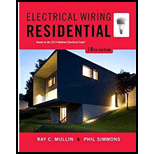
Electrical Wiring: Residental - With Plans (Paperback) Package
18th Edition
ISBN: 9781305416376
Author: MULLIN
Publisher: Cengage
expand_more
expand_more
format_list_bulleted
Concept explainers
Question
Chapter 15, Problem 14R
To determine
Name the type of protection used when the motor is running with overcurrent for the dryer.
Expert Solution & Answer
Trending nowThis is a popular solution!

Students have asked these similar questions
Choose the correct answer for from the following sentences:
1. The purpose of the microprocessor is to control
b. memory
c. processing
d. tasks
a. switches
2. Which of the following instructions represents base-plus-index addressing mode?
a. MOV AL,[BX] b. MOV AL,[SI] c. MOV AL,BX d. MOV AL,[BX+SI]
3. The BIU pre-fetches the instruction from memory and store them in
b. memory
c. stack
d. queue
a. register
4. Which function is used to control the PWM (Pulse Width Modulation) on the Arduino
output pin?
a. digitalRead() b. analogRead() c. digitalWrite()
5. Which port in the PIC16F877A has an 8 external interrupt inputs?
a. Port-A
b. Port-C
c. Port-B
d. analogWrite()
d. Port-D
d. 4KByte
6. How much Flash EEPROM memory program found in the PIC16F877A microcontroller?
a. 32KByte
b. 16KByte
c. 8KByte
Solve and select the correct answer:
2. For a random variable X with pdf: p(x)
value of x is
=
119
10
for -5≤x≤5. The mean
(a) -75
(b) 10
(c) 0
(d) 75
3. Is the matrix A = = [1] orthogonal? Find the rank of A?
0
(a) YES, -1
(b) NO, 2
(c) YES, 2
(d) NO, -1
4. L{et sin(3t)u(t)) = (a)
s-3
(s-2)²+9
2
(b)
(5-3)² (c)
(s-3)²+4
S-2
3
(s-2)²+9
(d) (5-2)²+9
=
5. Given that x is a constant. Choose all the correct solutions for [∞ (AB)] =
(a) (AB)T (b) x ATBT
(c) α BTAT
(d) x (AB)T
DO NOT WANT AI WILL REJECT
Chapter 15 Solutions
Electrical Wiring: Residental - With Plans (Paperback) Package
Ch. 15 - Prob. 1RCh. 15 - Prob. 2RCh. 15 - What special type of switch is controlling the...Ch. 15 - Prob. 4RCh. 15 - The total estimated volt-amperes for Circuit B10...Ch. 15 - If an attic is accessible through a scuttle hole,...Ch. 15 - Prob. 7RCh. 15 - Prob. 8RCh. 15 - The following is a layout of the lighting circuit...Ch. 15 - Prob. 10R
Ch. 15 - Prob. 11RCh. 15 - a. What is the minimum power demand allowed by the...Ch. 15 - What is the maximum permitted current rating of a...Ch. 15 - Prob. 14RCh. 15 - a. Must the metal frame of an electric clothes...Ch. 15 - An electric dryer is rated at 7.5 kW and 120/240...Ch. 15 - When a metal junction box is installed as part of...Ch. 15 - A residential air-conditioning unit is installed...Ch. 15 - The Code states that a means must be provided to...
Knowledge Booster
Learn more about
Need a deep-dive on the concept behind this application? Look no further. Learn more about this topic, electrical-engineering and related others by exploring similar questions and additional content below.Similar questions
- 3. Roughly sketch the root locus for the following locations of open-loop poles and zeros. You just need to show the shape of the root locus; you do not calculate the asymptote, break-in, and break-away points. ☑ (a) (b) ☑ Φ ① $3 (c)arrow_forwardDO NOT WANT AI WILL REJECTarrow_forwardDO NOT NEED AI WILL REJECTarrow_forward
- S+4 4. Sketch the root locus for L(s) = (s+6) (s+1)2 using rules 1, 2, and 3. For rule 3, you need to find the value of σ and a for the asymptotes. From the root-locus, explain why the closed-loop system is always stable for any choice of the design parameter K in the range 0 < K < ∞o.arrow_forward2. Consider the following system. K(s+3) (s+4) (s+1)(s+2) Check whether the points below are in the root locus. If the point is in the root locus, then also find what the corresponding gain K. i) ii) -2+j3 -2+1√ √ Hint: First find L(s). Next, in L(s) replace s with the value of the point and then express it in polar format r20 using calculator. The point will be in the root locus if and only if = 180° or odd multiple of 180°. When the point is in the root locus, the corresponding gain K is obtained as K ==arrow_forwardsolve and show workarrow_forward
- Design and find values. please solve ASAP (it's for practice before an exma, I don't have time)arrow_forwardCan you show why the answer is that for this question using second order differential equations, instead of laplace transformsarrow_forward2. For each of the following transfer functions, G(s) = Y(s)/U(s), find the differential equation relating the input u(t) to the output y(t). (s+2)(s+3) (a) G(s) = (s+1)(s+4) (s²+0.4s+1.04) (s+3) (b) G(s)= (s2+0.2s+1)(s+2)(s+4)arrow_forward
arrow_back_ios
SEE MORE QUESTIONS
arrow_forward_ios
Recommended textbooks for you
 EBK ELECTRICAL WIRING RESIDENTIALElectrical EngineeringISBN:9781337516549Author:SimmonsPublisher:CENGAGE LEARNING - CONSIGNMENT
EBK ELECTRICAL WIRING RESIDENTIALElectrical EngineeringISBN:9781337516549Author:SimmonsPublisher:CENGAGE LEARNING - CONSIGNMENT

EBK ELECTRICAL WIRING RESIDENTIAL
Electrical Engineering
ISBN:9781337516549
Author:Simmons
Publisher:CENGAGE LEARNING - CONSIGNMENT